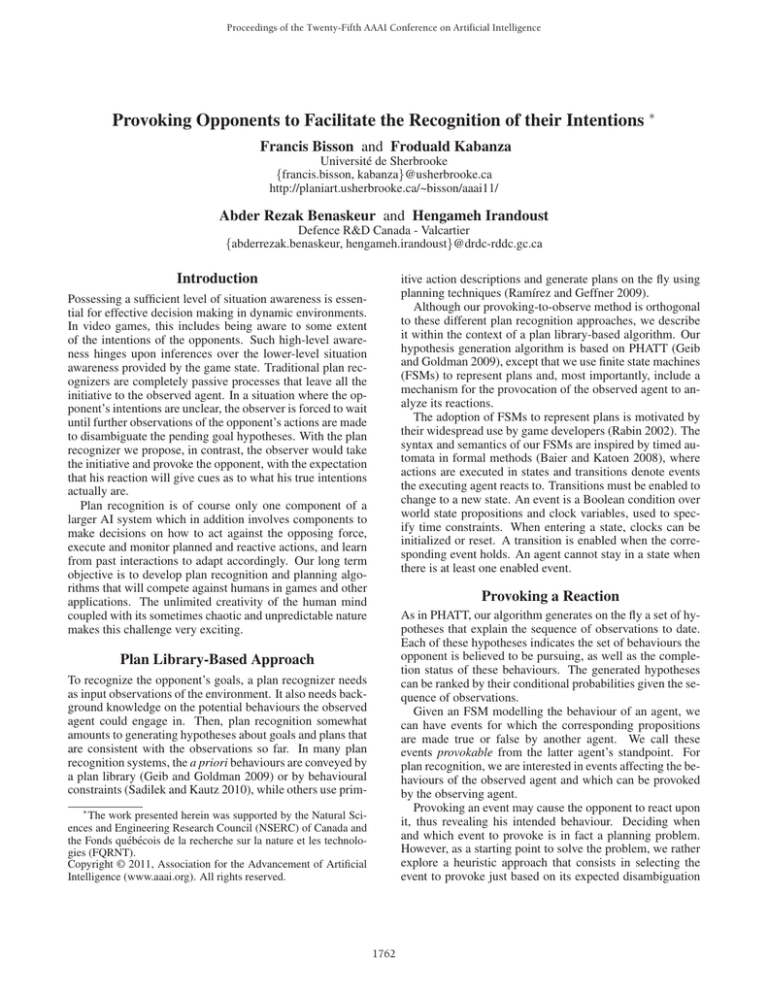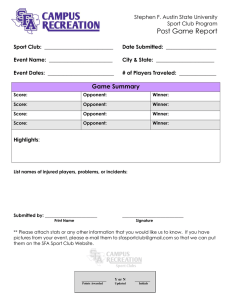
Proceedings of the Twenty-Fifth AAAI Conference on Artificial Intelligence
Provoking Opponents to Facilitate the Recognition of their Intentions ∗
Francis Bisson and Froduald Kabanza
Université de Sherbrooke
{francis.bisson, kabanza}@usherbrooke.ca
http://planiart.usherbrooke.ca/~bisson/aaai11/
Abder Rezak Benaskeur and Hengameh Irandoust
Defence R&D Canada - Valcartier
{abderrezak.benaskeur, hengameh.irandoust}@drdc-rddc.gc.ca
Introduction
itive action descriptions and generate plans on the fly using
planning techniques (Ramı́rez and Geffner 2009).
Although our provoking-to-observe method is orthogonal
to these different plan recognition approaches, we describe
it within the context of a plan library-based algorithm. Our
hypothesis generation algorithm is based on PHATT (Geib
and Goldman 2009), except that we use finite state machines
(FSMs) to represent plans and, most importantly, include a
mechanism for the provocation of the observed agent to analyze its reactions.
The adoption of FSMs to represent plans is motivated by
their widespread use by game developers (Rabin 2002). The
syntax and semantics of our FSMs are inspired by timed automata in formal methods (Baier and Katoen 2008), where
actions are executed in states and transitions denote events
the executing agent reacts to. Transitions must be enabled to
change to a new state. An event is a Boolean condition over
world state propositions and clock variables, used to specify time constraints. When entering a state, clocks can be
initialized or reset. A transition is enabled when the corresponding event holds. An agent cannot stay in a state when
there is at least one enabled event.
Possessing a sufficient level of situation awareness is essential for effective decision making in dynamic environments.
In video games, this includes being aware to some extent
of the intentions of the opponents. Such high-level awareness hinges upon inferences over the lower-level situation
awareness provided by the game state. Traditional plan recognizers are completely passive processes that leave all the
initiative to the observed agent. In a situation where the opponent’s intentions are unclear, the observer is forced to wait
until further observations of the opponent’s actions are made
to disambiguate the pending goal hypotheses. With the plan
recognizer we propose, in contrast, the observer would take
the initiative and provoke the opponent, with the expectation
that his reaction will give cues as to what his true intentions
actually are.
Plan recognition is of course only one component of a
larger AI system which in addition involves components to
make decisions on how to act against the opposing force,
execute and monitor planned and reactive actions, and learn
from past interactions to adapt accordingly. Our long term
objective is to develop plan recognition and planning algorithms that will compete against humans in games and other
applications. The unlimited creativity of the human mind
coupled with its sometimes chaotic and unpredictable nature
makes this challenge very exciting.
Provoking a Reaction
As in PHATT, our algorithm generates on the fly a set of hypotheses that explain the sequence of observations to date.
Each of these hypotheses indicates the set of behaviours the
opponent is believed to be pursuing, as well as the completion status of these behaviours. The generated hypotheses
can be ranked by their conditional probabilities given the sequence of observations.
Given an FSM modelling the behaviour of an agent, we
can have events for which the corresponding propositions
are made true or false by another agent. We call these
events provokable from the latter agent’s standpoint. For
plan recognition, we are interested in events affecting the behaviours of the observed agent and which can be provoked
by the observing agent.
Provoking an event may cause the opponent to react upon
it, thus revealing his intended behaviour. Deciding when
and which event to provoke is in fact a planning problem.
However, as a starting point to solve the problem, we rather
explore a heuristic approach that consists in selecting the
event to provoke just based on its expected disambiguation
Plan Library-Based Approach
To recognize the opponent’s goals, a plan recognizer needs
as input observations of the environment. It also needs background knowledge on the potential behaviours the observed
agent could engage in. Then, plan recognition somewhat
amounts to generating hypotheses about goals and plans that
are consistent with the observations so far. In many plan
recognition systems, the a priori behaviours are conveyed by
a plan library (Geib and Goldman 2009) or by behavioural
constraints (Sadilek and Kautz 2010), while others use prim∗
The work presented herein was supported by the Natural Sciences and Engineering Research Council (NSERC) of Canada and
the Fonds québécois de la recherche sur la nature et les technologies (FQRNT).
Copyright © 2011, Association for the Advancement of Artificial
Intelligence (www.aaai.org). All rights reserved.
1762
rithm and with a probability of 0.946 using our algorithm.
Moreover, the earliest detection time is preceded by approximately 20 % of the plan’s completion. Although the
provocation of events generally improves the goal recognition process, it sometimes increases the probability of some
hypotheses that are wrong to begin with. In the experiments,
these hypotheses tend to be eliminated later as more actions
are observed. This can be seen on the figure where the solid
red curve is below the dashed green curve. This means that,
with the approach as it stands now, the selection of the best
event to provoke is heavily dependent on the accuracy of the
underlying recognition system.
of the current set of hypotheses. For each provokable event,
we compute the expected reduction of the uncertainty on the
opponent’s intentions, knowing how he would react to the
provocation. We use entropy as a measure of uncertainty associated with the set of hypotheses, and determine the provokable event that is expected to reduce it the most.
By simulating the opponent’s potential reactions as if he
had been provoked, we get new sets of hypotheses. We then
average the entropy of each resulting situation over the potential reactions to the provocation of an event, and compare
them with the entropy of the current set of hypotheses. The
codomain of this expected disambiguation D is [−1, 1], each
extreme marking a situation where the ambiguity on the opponent’s intentions has been exacerbated in the worst possible way or completely removed, respectively. Thus, the
best event to provoke is the one with the largest D value.
If this value is negative, it might be better to simply wait
instead of voluntarily risking to increase the uncertainty on
the opponent’s intentions. Accordingly, our goal recognition
algorithm takes as input two thresholds, one for the minimal
entropy and the other for the minimal expected disambiguation. If both thresholds are met, the provocation of the event
is given as a goal to a deterministic forward-chaining planner
to produce a plan leading to a state where the event holds.
Conclusion
We presented a method of provoking the opponent during
plan recognition based on the expected disambiguation of
the current set of goal hypotheses. A comparison to the
PHATT algorithm demonstrated that such a technique is indeed a useful addition to the algorithm to improve its accuracy and earliest time detection.
The current implementation is only a starting step in exploring this idea of provoking to observe the reaction in plan
recognition. Currently, we only consider the opponent’s immediate reaction to a provocation. The next step of our investigation is to consider the longer term effect of a provocation on the opponent’s behaviours as well as on the observer’s own goals. Indeed, it is possible that by provoking,
the observer may, in turn, make himself vulnerable. We plan
to examine an integrated planning and plan recognition approach in which the decision to provoke takes into account
the impacts on the observer’s goals, the cost of actions, and
the plans he is currently committed to.
An important obstacle to plan library-based approaches
in adversarial domains is that it is virtually impossible to
script all potential behaviours in a plan library. Learning
behaviours remains an important research avenue to face this
obstacle.
The ultimate test of a plan recognition algorithm is when
it is embedded into an effective planning and plan execution architecture. Future evaluations of our approach will
involve comparisons with alternative methods by integrating the compared plan recognizers in a game AI and have
them compete against one another to see which one wins.
Experimental Results
Goals Recognition (%)
We conducted several experiments, producing very encouraging, albeit preliminary, results, given that we adopted
a heuristic approach to the problem instead of the fullyfledged provocation planning approach. We scripted the opponent’s goals as pairs of behaviours selected from a set of
5 potential behaviours from an artificial domain with very
similar prefixes, making them hard to be identified by a typical goal recognition algorithm. We then let the opponent
randomly select actions pertaining to his plans and had the
observer try to recognize the opponent’s goals. We generated 500 such scenarios and measured the average probability that the correct goal was recognized properly by each
algorithm, with respect to the percentage of completion of
the opponent’s plans. The results are reported in Figure 1.
1
Our Approach
PHATT
0.8
References
0.6
Baier, C., and Katoen, J.-P. 2008. Principles of Model
Checking. The MIT Press.
Geib, C., and Goldman, R. 2009. A probabilistic plan recognition algorithm based on plan tree grammars. Artificial Intelligence 117(11):1101–1132.
Rabin, S. 2002. AI Game Programming Wisdom. Rockland,
MA, USA: Charles River Media, Inc.
Ramı́rez, M., and Geffner, H. 2009. Plan recognition as
planning. In Proceedings of the 21st International Joint
Conference on Artificial Intelligence (IJCAI).
Sadilek, A., and Kautz, H. 2010. Recognizing multi-agent
activities from GPS data. In Proceedings of the 24th Conference on Artificial Intelligence (AAAI).
0.4
0.2
0
0
0.2
0.4
0.6
0.8
Plans Completion (%)
1
Figure 1: Experimental results
As the figure shows, the average accuracy of the goal
recognition process was improved by the enhanced algorithm. The correct goal was, on average, correctly identified with a probability of 0.762 using the PHATT algo-
1763




